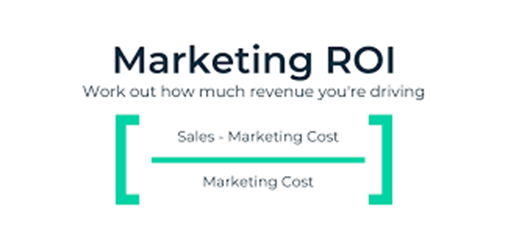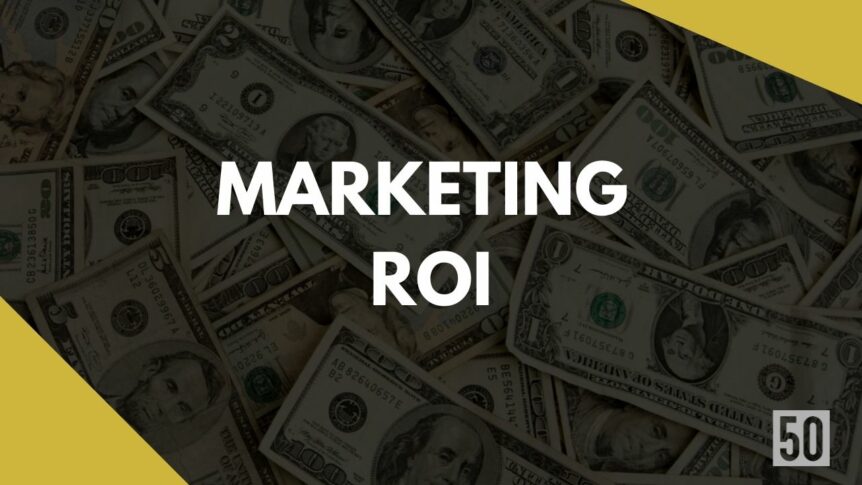Do you want to know the secret to successful marketing? It’s about something other than spending a ton of money or using the latest and greatest strategy. In fact, the key to success is something you’re probably already doing – tracking your return on investment (ROI). By measuring how much revenue each marketing tactic generates, you can determine which strategies are worth your time and money and continue investing in them. And that’s where marketing ROI comes in. Read on to find out why this simple metric is the best way to grow your business.
What Is Marketing ROI?
Marketing ROI is a measure of the return on investment for marketing activities. It is a way to compare the effectiveness of different marketing strategies in terms of their ability to generate sales or leads.
Marketing ROI is calculated by dividing the total revenue generated by the marketing campaign by the total cost of the campaign. The resulting number is then expressed as a percentage. Simply put, marketing ROI measures how much money you make for every dollar you spend on marketing. While many factors can affect marketing ROI, it is generally agreed that campaigns with a high marketing ROI are considered successful.
For example, a campaign that generates $10 in sales for every $1 spent on marketing would have a 10% marketing ROI.
In contrast, a campaign that only generates $2 in sales for every $1 spent would have a 2% marketing ROI. As you can see, marketing ROI can be a valuable metric for evaluating the success of your marketing efforts.
How Can Marketing ROI Help Your Business Grow?
Marketing ROI is a key metric for businesses to track in order to determine the efficacy of their marketing campaigns. By calculating the return on investment for each marketing campaign, businesses can make informed decisions about where to allocate their resources.
Marketing ROI can also help businesses to set realistic expectations for their campaigns. If a campaign is not achieving the desired return, it can be quickly adjusted or discontinued.
Furthermore, tracking marketing ROI can help businesses to identify which channels are most effective for reaching their target audiences. As a result, businesses that focus on marketing ROI are able to allocate their resources more effectively and grow at a faster rate.
How To Calculate Marketing ROI?
Marketing has always been a bit of an art and a bit of a science. The science comes in when you try to calculate the return on investment (ROI) for your marketing campaigns. ROI is a simple equation: you take the sales growth from that business or product line, subtract the marketing costs, and then divide it by the marketing cost.
So, if sales grew by $1,000 and the marketing campaign cost $100, then the simple ROI is 900%. (($1000-$100) / $100) = 900%. Of course, things are rarely that simple in the real world.
Many factors can affect your sales growth, and it can be difficult to isolate the impact of your marketing campaigns. However, calculating ROI is still valuable because it forces you to think carefully about your goals and objectives for each campaign.
And, even if the final number could be more perfectly accurate, it can give you a good general idea of whether your marketing efforts are paying off.

What Is A Good Marketing ROI?
A good marketing ROI is typically considered a 5:1 ratio, with exceptional ROI at around a 10:1 ratio. This means that for every $1 spent on marketing, the organization will see a return of $5 (or more).
Ratios below 2:1 are not generally considered profitable, as the costs of producing and distributing goods/services often mean that organizations will only break even with their spending. However, it’s important to remember that Marketing is a complex function and should be looked at holistically when determining ultimate profitability.
For example, if an organization spends $10,000 on marketing and sees a return of $50,000, but the cost of goods or services is $40,000. The actual profit generated would only be $10,000 – not taking into account any other organizational costs.
In this case, the organization would only have a 1:1 ratio, which is not indicative of successful marketing efforts. As such, it’s important to consider all factors when determining marketing ROI.
Examples Of Marketing ROI
Example 1
A small business that sells women’s fashion accessories spends $500 on a Google Ads campaign promoting its new line of summer purses. The ads result in 400 clicks and generate $4,000 in sales.
Here’s how their ROI would be calculated:
{(($4,000 – $500) ÷ $500)} x 100 = 700%
If this rate of return works for the firm, they might want to continue the strategy as is. If they like the strategy but want to increase the ROI, they might try bidding on more competitive keywords or increasing their budget.
Example 2
A furniture company spends $1,000 on a Facebook ad campaign that targets people who live in a certain zip code and are interested in interior design. The ads result in 2,000 impressions and 100 clicks. Of those who clicked, 10% visited the furniture company’s website, and 5% made a purchase.
Here’s how their ROI would be calculated:
{(($500 – $1,000) ÷ $1,000)} x 100 = -50%
While a 50% ROI might not seem great, the furniture company might continue running the ads because they only spent $1,000. They might also want to tweak their target audience or ad copy to see if they can get better results.
Digital Marketing ROI By Channel
Here is an example of marketing ROI by channel:
| Channel | Time to Break Even | ROAS
(3 year average) |
ROI
(3 year average) |
| SEO | 9 months | 9.10 | 748% |
| SEM/PPC | 4 months | 1.55 | 36% |
| E-mail Marketing | 7 months | 3.50 | 261% |
| LinkedIn – Organic | 5 months | 2.75 | 229% |
| LinkedIn – Paid | 5 months | 2.30 | 192% |
| Facebook Ads | 3 months | 1.80 | 87% |
| Webinars | 9 months | 4.95 | 430% |
| Influencer Marketing | 6 months | 3.45 | 206% |
| Online PR | 8 months | 1.60 | 62% |
Digital Marketing ROI by Industry (Highest ROI Channels)
The marketing ROI by industry is illustrated as:
| Industry | Highest ROI Channels |
| Addiction Treatment |
|
| Automotive |
|
| B2B SaaS |
|
| Biotech |
|
| Business Insurance |
|
| Construction |
|
| eCommerce |
|
| Financial Services |
|
| Fintech |
|
| Healthcare |
|
| Heavy Equipment |
|
| Higher Education |
|
| HVAC |
|
| Industrial IOT |
|
| IT & Managed Services |
|
| Law Firms & Legal Services |
|
| Manufacturing & Distribution |
|
| Medical Device |
|
| Oil & Gas |
|
| PCB Design & Manufacturing |
|
| Pharmaceutical |
|
| Real Estate |
|
| SaaS |
|
| Solar Energy |
|
| Staffing & Recruiting |
|
What Are the Challenges of Measuring Marketing ROI?
Measuring marketing ROI can be challenging for several reasons.
- First, it can be difficult to isolate the specific effects of marketing campaigns from other factors that contribute to sales. For example, if a company launches a new advertising campaign and sales increase, it is difficult to say definitively that the campaign was responsible for the uptick.
- Other factors such as changes in the economy or seasonality might also have played a role. In addition, some marketing activities, such as branding, are designed to build long-term awareness and loyalty rather than generate immediate sales. As a result, it can be hard to assess the short-term ROI of these activities.
- Finally, calculating ROI requires access to detailed data on sales, costs, and customer behavior, which can be difficult to obtain.
Despite these challenges, measuring marketing ROI is essential for making informed decisions about where to allocate marketing resources. With careful planning and execution, companies can develop strategies for tracking and assessing the return on their marketing investments.
Tips For Improving Marketing ROI
There are a number of ways to improve marketing ROI, but the most important factor is to track and measure the results of your marketing campaigns. By understanding which campaigns are performing well and which ones are not, you can make adjustments to improve your overall marketing ROI.
Here are a few tips for improving marketing ROI:
Set realistic goals
Before launching a marketing campaign, take the time to set realistic goals. Consider what you hope to achieve with the campaign and set measurable objectives. This will help you track and measure your progress along the way.
Track your results
Make sure to track the results of your marketing campaigns. This includes both online and offline metrics. By understanding which tactics are performing well, you can adjust your strategy accordingly.
Focus on quality over quantity
It’s important to focus on quality over quantity in your marketing campaigns. Don’t try to reach everyone with your message. Instead, focus on targeting a specific audience with a well-crafted message.
Test different tactics
Don’t be afraid to experiment with different marketing tactics. By testing different approaches, you can find the ones that work best for your business.
Be patient
Good things take time. Don’t expect to see results overnight. Marketing campaigns can take weeks or even months to produce results. Be patient and continue to track your progress.
By following these tips, you can improve your marketing ROI and get the most out of your marketing campaigns.

